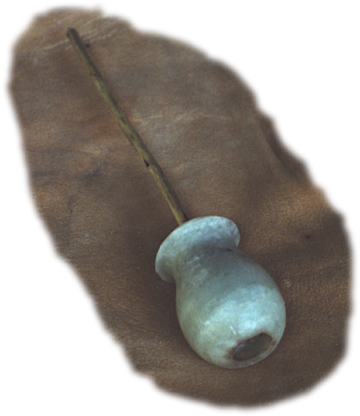Cameahwait’s Pipe
The day, 13 August 1805, was an exceptionally full and fateful day, even for Meriwether Lewis. It really started off with a chance meeting with an old Lemhi Shoshone woman, which made up for all the weeks of growing anxiety and frustration. But it was when Cameahwait took him into the shelter of the only leather lodge his people had been able to save from the Hidatsas‘ depredations of the previous spring, that he knew for sure he was among good friends.
the Chief then lit his pipe at the fire kindled in this little magic circle, and standing on the oposite side of the circle uttered a speach of several minutes in length at the conclusion of which he pointed the stem to the four cardinal points of the heavens first beginning at the East and ending with the North. he now presented the pipe to me as if desirous that I should smoke, but when I reached my hand to receive it, he drew it back and repeated the same cremony three times, after which he pointed the stem first to the heavens then to the center of the magic circle smoked himself with three whifs and held the pipe untill I took as many as I thought proper; he then held it to each of the white persons and then gave it to be consumed by his warriors.
this pipe was made of a dense simitransparent green stone very highly polished about 2½ inches long and of an oval figure, the bowl being in the same direction with the stem. a small piece of birned clay is placed at the bottom of the bowl to seperate the tobacco from the end of the stem and is of an irrigularly rounded figure not fitting the tube purfectly close in order that the smoke may pass. this is the form of the pipe.[1]Lewis’s drawing of the pipe is from his journal of 13 August 1805, courtesy of the American Philosophical Society (Codex F, p. 99).
their tobacco is of the same kind of that used by the Minnetares [Hidatsas] Mandans and ricares [Arikaras] of the Missouri.[2]The tobacco Lewis refers to is Native tobacco, Nicotiana quadrivalvis, a mild species of the genus to which the much more potent and addictive Nicotiana vulgaris belongs. the Shoshonees do not cutivate this plant, but obtain it from the Rocky mountain Indians and some of the bands of their own nation who live further south.
Curiosities
The day was crowded with some of the most momentous events of the entire expedition, and with omens both good enough and bad enough to leave no room for any other thoughts. Nevertheless, Lewis’s compulsive curiosity and incisive observational powers absorbed some of the smallest details scattered along the way.
We can imagine him asking for a closer look at the tobacco in Caheahwait’s pouch, rubbing a bit of it between his fingers, and directing Drouillard to sign a couple of questions to Cameahwait. A flurry of deadpan gestures are handed back and forth, back and forth. Drouillard translates them for Lewis into an English richly flavored with Canadian French, Shawnee, and creole patois.
Snowberries and Soapstone
Early that morning, descending the mountain toward the “handsome little valley,” he observed some bushes intently, and perhaps jotted a few words in his pocket notebook to record later that he had seen a new species of shrub, which called to his mind the wolfberry of the lower Missouri. Along the road across the “wavy plain,” scarcely missing a step, he analyzed the dusty soil—”of a light yellow clay, intermixed with small smooth gravel, and produces little else but prickly pears, and bearded grass about 3 inches high.” He recognized a plant he called “a species of honeysuckle,” [snowberry] and took note of three species of prickly pear cactus.
Possibly the “simitransparent green stone” was what is today called talc, a magnesium silicate which in its purest form is called steatite (from the Greek word for tallow), or soapstone. It is among the softest of all minerals, and has been used since ancient times for carving utensils and ornaments. The Shoshones probably mined it from the mountains drained by the Ruby River, the stream Lewis named “Philanthropy,” after one of the cardinal virtues of Freemasonry.[3]See Lewis as Master Mason. Today, talc is an essential ingredient in the ceramic cores of catalytic converters, and also is used in the manufacture of dusting powders, lubricants, roofing materials, plastics, paper, and paint. Soapstone is sometimes used to make sinks and countertops.
Notes
| ↑1 | Lewis’s drawing of the pipe is from his journal of 13 August 1805, courtesy of the American Philosophical Society (Codex F, p. 99). |
|---|---|
| ↑2 | The tobacco Lewis refers to is Native tobacco, Nicotiana quadrivalvis, a mild species of the genus to which the much more potent and addictive Nicotiana vulgaris belongs. |
| ↑3 | See Lewis as Master Mason. |
Experience the Lewis and Clark Trail
The Lewis and Clark Trail Experience—our sister site at lewisandclark.travel—connects the world to people and places on the Lewis and Clark Trail.
Discover More
- The Lewis and Clark Expedition: Day by Day by Gary E. Moulton (University of Nebraska Press, 2018). The story in prose, 14 May 1804–23 September 1806.
- The Lewis and Clark Journals: An American Epic of Discovery (abridged) by Gary E. Moulton (University of Nebraska Press, 2003). Selected journal excerpts, 14 May 1804–23 September 1806.
- The Lewis and Clark Journals. by Gary E. Moulton (University of Nebraska Press, 1983–2001). The complete story in 13 volumes.



